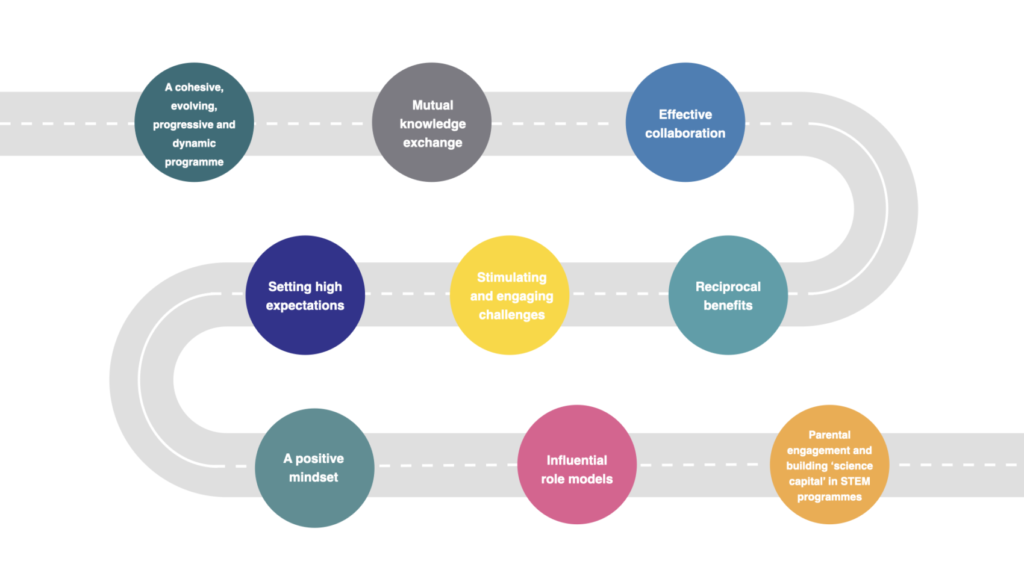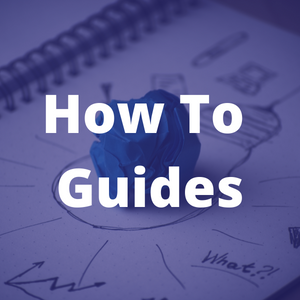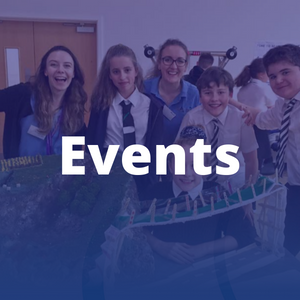
Any education programme should aim to provide the highest standards of learning for young people and set high expectations.
These standards are measured in both quantitative and qualitative terms – by the programme’s popularity and success with participants, its appeal to diverse groups and contexts, by the outcomes and achievements engendered for young people and by longer-term factors such as their career destinations.
So how are high standards and expectations attained through education-industry partnerships?
Suggested below are some features that help define what needs to be accomplished:
- A cohesive, evolving, progressive and dynamic programme of learning
- Mutual knowledge exchange
- Effective collaboration
- Reciprocal benefits
- Stimulating and engaging challenges
- Setting high expectations
- A positive mindset
- Influential role models
- Parental engagement and building ‘science capital’1 in STEM programmes.

A cohesive, evolving, progressive and dynamic programme
The education programme should be relevant to all those involved and align closely to the curriculum.
It should have an overall strategic vision; develop in logical stages; embed progressive learning; and never become static.
Mutual knowledge exchange
Strong education-industry partnerships require a mutual exchange of knowledge and expertise, a reciprocal relationship recognising and paying heed to professional qualities and perspectives on each side.
Providing opportunities for professional learning for education/industry practitioners and teachers (who are key influencers of young people) will help to bring about systemic and lasting change.
Effective collaboration
Collaboration should be based on co-operative approaches, openness, sharing and joint ownership so that the potential of the partnership is fully realised.
This approach relies on trust, mutual respect, integrity, conscious inclusion, equality and support.
Effectiveness is measured in terms of the overall success of the programme and appropriate negotiation of different perspectives.
Reciprocal benefits
Each partner should benefit from participation and the partnership/programme should satisfy the varying needs of all.
Benefits can be seen to accrue, for example, from co-operating on a venture that meets organisational or policy objectives or is compatible with the demands of government strategy.
Further benefits derive when the partnership/programme is put into effect – from the actual sharing of knowledge and expertise and from witnessing the professionalism of partners.
Stimulating and engaging challenges
The programme should provide genuine opportunities to challenge participants.
Programme events should be stimulating, offering varied learning experiences that require new ways of thinking, acting and problem-solving at different levels.
This applies not only to the young people on the programme, but also to those who plan and deliver events.
Boundaries and capabilities should be tested for all.
Experimentation/trialling should be embedded.
Appropriate levels of risk should be welcomed.
Participants should be encouraged to ‘have a go’.
Setting high expectations
Conveying high expectations to young people helps engender high levels of achievement.
A positive mindset
Effective education programmes should impact on participants’ skills, capabilities, attitudes and perspectives on learning.
A desirable outcome is that participants become more confident, resilient and motivated because of their involvement.
Appropriately designed challenges and problem-solving opportunities engender a positive mindset in which belief in oneself and one’s own attributes is re-affirmed and reinforces motivation and aspiration.
Influential role models
The programme should include positive role models.
These might be young industry professionals leading and facilitating classroom events, sharing their personal career pathways and experiences, or it might involve senior pupils acting as mentors to assist younger pupils’ learning.
Role models can challenge traditional stereotypes (e.g. about gender, careers, black and minority ethnic background, disability and those who are care-experienced).
Role models feature as part of the key recommendations in the Developing the Young Workforce Programme, where all materials and visits demonstrate the diversity of the workforce.
For guidance on improving e.g. the gender balance in STEM, see the suite of materials on Education Scotland’s National Improvement Hub2
Parental engagement and building ‘science capital’ in STEM programmes
The Aspires Research programme3 and Improving Science Participation programme4 both reflect the importance of engaging with parents and families in STEM interventions.
Parents and families are key influencers over young people’s subject and career choices and efforts to increase science capital within families and communities is crucial if we are to persuade increasing numbers of young people to pursue STEM careers.
This research also points to other important findings such as the relatively young age at which many young people make career choices and how young people perceive STEM subjects as being only for the ‘very brainy’.
Adopting these principles and practices provides a foundation for creating effective education programmes. Genuinely collaborative partnerships between education and industry can be a catalyst for transforming approaches to learning. If this is combined with promoting a positive mindset that instils resilience, confidence and inquisitiveness, these programmes will contribute to developing a young workforce that is well-equipped to embrace the challenges of the future.
References
1 – The concept of ‘science capital’ refers to “all of an individual’s science-related resources – their attitudes and understanding of science, science-related interests and activities and social contacts,” as defined in Archer, L., Dewitt, J., King, H. (2018), Improving Science Participation – Five evidence-based messages for policy-makers and funders.
2 – Education Scotland, Improving Gender Balance 3-18.
3 – Aspires: Young People’s Science and Careers Aspirations, aged 10-14
4 – Improving Science Participation: Five evidence-based messages for policy-makers and funders:




